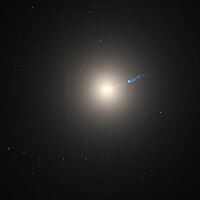
Photo from wikipedia
In this work, simultaneous global optimization of geometry and total spin of small iron clusters Fen (3 ≤ n ≤ 40) is assessed using Simulated Annealing (SA) simulations with forces… Click to show full abstract
In this work, simultaneous global optimization of geometry and total spin of small iron clusters Fen (3 ≤ n ≤ 40) is assessed using Simulated Annealing (SA) simulations with forces calculated at the DFT-based Tight-Binding (DFTB) level of theory. In order to optimize the total spin, the occupancies of α and β densities were allowed to relax at each SA step, resulting in a continuous variation of the total spin along the trajectory. The behavior and performance of the procedure were investigated running two series of 10 independent "long" molecular dynamics simulations and one series of 100 independent "short" simulations. Cluster structures optimized with the assessed methodology reproduced geometries and magnetic moments reported in a previous work very well where multiple fixed total spin and geometries of iron clusters were individually probed, and for some clusters, more stable global minima were found. Other properties such as binding energies and second energy differences were also calculated in order to compare with previously reported theoretical and experimental values. The few mismatches were found to be driven by quasi degenerated ground states with different magnetic moments or by states with crossing free energies at high temperatures.
Journal Title: Journal of chemical theory and computation
Year Published: 2022
Link to full text (if available)
Share on Social Media: Sign Up to like & get
recommendations!